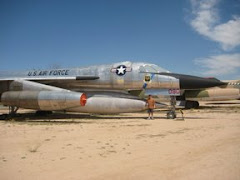That morning, P-38L #44-24350 would have been fueled and readied for its coming flight. The two Allison V-1710s would have been readied for their flight to 25,000 feet. The fluids topped off and everything fixed as well as possible. Start up would have been followed by a taxi out to the active runway. All four ships would have checked their brakes and their engines would have been run up. Then, with a signal from the lead pilot, all four would have rushed down the runway. Or, if they were taking off one-by-one, the lead would have taken off and started on a slight turn, the next a slightly sharper turn, and the third a sharper turn than that, and so on. All would have joined up eventully and made the long climb to 20,000 feet.
The point of this exercise would have been to familiarize the new pilots with operating at altitude with oxygen masks and all the attendant difficulties associated with completing a mission profile. Eventually they would likely have been tasked with long range navigation and other onerous tasks while wearing oxygen masks. On this mission, though, the lead pilot, 1st Lt. Clarence Seltz, had instructed the flight to spread out and feel the plane out at 25,000 feet. The air is thinner there and the plane would have acted slightly differently than it would have at 5,000 feet.
Ingersoll's aircraft broke from the formation in a normal way, according to the number four pilot, 2nd Lt. Edward Meeker. Meeker continued to fly wing on Ingersoll until they had lost about 3,000 feet, at which time Ingersoll's aircraft had become difficult to fly formation on. Meeker broke off. When he broke off from Ingersoll, Meeker said that Ingersoll was very erratic and turning very fast, so that Meeker could not make out which way he was going. He rejoined with the leader at 25,000 feet expecting Ingersoll to rejoin also. This happened about 0930. The flight landed at 1000. Ingersoll never did joined up.
The Accident Board determined that the crash was caused by the pilot experiencing compressibility. A phenomenon encountered when the P-38 (and other aircraft of the era) reached too high of a speed and the air around it interacted with the aircraft controls in ways that made controlled flight difficult to impossible. Usually the latter. Compressibility created a nose down condition in the P-38, which continued to induce compressibility. Few control inputs could help the problem once it was encountered in full force. Ingersoll's aircraft began to break apart in flight at about 4,000 feet.
Ed Knecht "observed" the accident from a distance. He said he saw pieces come from the aircraft, but could not identify what those pieces were.
The board decided Ingersoll had encountered compressibility and used elevator trim with no success, then he used the dive flaps, at which time the aircraft responded, but, at the speeds and forces in question, the aircraft disintegrated, and the "G" forces encountered killed the pilot. The second theory was that the pilot experienced hypoxia.
The accident board suggested that it was pilot error, because no malfunction with the aircraft could be found. It was not an old aircraft; it had less than 53 hours on it. Still, he should have been familiar with compressibility. The other possibility was "Oxygen Starvation" or Hypoxia. Two days prior to the accident, Ingersoll had crash landed another P-38. His personal oxygen mask was found in the first crashed P-38 after this crash. It was supposed that he had borrowed a different oxygen mask, which may not have been fitted in the correct fashion, thus causing hypoxia. If his oxygen mask had not fit perfectly, it seems possible that he may have experienced oxygen starvation. He had been through 9 hours of high altitude formation flying. He had been through the oxygen chamber. He knew what could happen. He may not have recognized the signs, however. Having lost consciousness it is not a great leap to assume he lost control, too. The P-38 dove, gaining speed until it encountered compressibility which induced even more nose down attitude, which increased speed. When he was finally low enough to recover from his daze, he may have tried to lower the dive brakes, but it was too late.
The committee recommended that flight leads make sure that their charges were fitted with the correct oxygen masks, since they were in a position to make sure of such things.
Thank You, 2nd Lieutenant Ingersoll for your sacrifice.







No comments:
Post a Comment